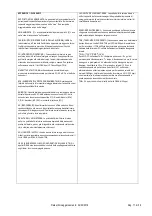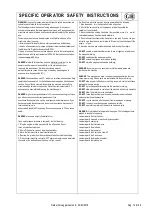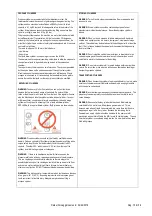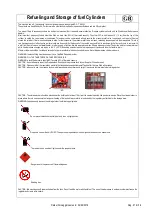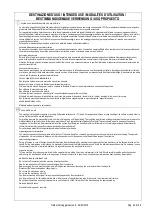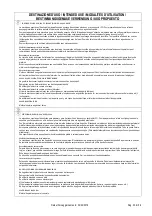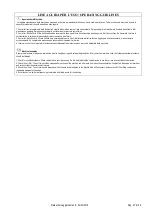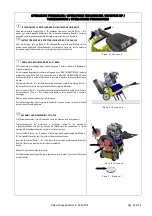
Data ultimo aggiornamento: 04/04/2018
Pag. 17 di 56
-by unqualified or untrained personnel;
-unless properly maintained and adjusted;
-on areas with obstructions such as thresholds, floor outlet boxes, etc. ;
-in areas where loose debris or other objects are present;
-in rooms and areas without proper ventilation.
This machine is designed to burnish most modern types of floors including
composition tile, stone, marble, terrazzo, resilient floor covering and some
coated wood floors.
CAUTION
: The use of floor maintenance machines in buildings frequented by
the public, including the times when such buildings are occupied by the
public, shall require the approval of the authority having jurisdiction.
WARNING
: The operator is responsible for performing the recommended
daily maintenance and checkups of the machine to keep it in good working
condition. Keep your machine regularly maintained by following the
maintenance information in this manual. During and after operation, perform
the recommended daily and hourly procedures outlined in the Maintenance
Chart.
CANADIAN SAFETY REQUIREMENTS
1.
A sign indicating “NO SMOKING ” shall be permanently displayed
at the storage area. The sign shall be in accordance with the sign
required in Clause 10.12.3 of CAN/CGA-B149.2-M91, Propane
Installation Code.
2.
When the cylinder is attached to the floor maintenance machine
for use, the operator shall not leave the unit unattended except
for short periods of time such as rest stops, washroom, or meal
stops.
3.
The requirements of 1.10.1(e) and (g) do not apply in industrial
buildings.
4.
A floor maintenance machine shall only be used in buildings:
a. Provided with continuous mechanical ventilation that removes products of
combustion to the outdoors of not less that 300 CFM for each 10,000 BTU-hr
or fraction thereof.
b. Provided with natural ventilation of not less than 300 CFM for each 10,000
BTU-hr input or fraction thereof, based on a maximum of one-quarter-air
exchange per hour for the net building volume.
5.
The owner of a floor maintenance machine shall ensure that the
operator has participated in a course authorized by the
manufacturer of the unit on the safe handling of propane and the
safe operation of the machine.
6.
The owner of a floor maintenance machine shall ensure that the
unit is maintained in accordance with the manufacturer's
recommended maintenance procedures in a safe operating
condition and the owner shall maintain a record of the
maintenance for a period of two years.
7.
Before transporting a floor maintenance machine, the cylinder
shall be securely fastened with the system valve closed, and the
cylinder shall be located in a well-ventilated space.
APPENDIX: GLOSSARY
AIR-FUEL RATIO: The % of air combined with the % of fuel to make the
combustible gas. If the mixture is heavy with propane it is termed “rich”. If it
is heavy with air it is said to be “lean”.
AMBIENT AIR: [1] The air in the environment of the operator and/or others.
[2] The air in the “breathing zone” of the operator.
CARB (CALIFORNIA AIR RESOURCE BOARD): CARB has recommended
and the State of California has passed legislation that limits emission levels
for the outdoor power equipment industry. At present these are the most
restrictive limits set by any controlling organization.
CO (CARBON MONOXIDE): Carbon Monoxide is a colorless/odorless gas.
It replaces oxygen in the blood. The blood then cannot deliver oxygen to the
cells in the body. The symptoms of Carbon Monoxide Poisoning are
headaches, dizziness, and nausea. It can lead to asphyxiation and death.
The OSHA limits for CO are 50 ppm TWA.
CATALYTIC MUFFLER: Muffler containing a catalyst to promote the reaction
required to reduce the CO, HC and NOx to levels that are safe.
EPA (ENVIRONMENTAL PROTECTION AGENCY): This federal agency is
charged with enforcing the federal clean air act, which applies to outdoor air
quality.
EXHAUST EMISSIONS: Total amount of gases exhausted from internal
combustion engines while running. 94.5% of the emissions are non-toxic.
5.5% of the emissions are toxic and are composed of 0.1% Oxides of
Nitrogen (NOx); 0.1% Hydrocarbons (HC); 5.3% Carbon Monoxide (CO).
HC (HYDROCARBONS): Some Hydrocarbons have a narcotic effect. Some
cause irritation to mucous membranes. Some could be classified as cancer
causing. Others react with NOx in sunlight forming smog, which can irritate
the eyes and respiratory tract.
INDOOR AIR QUALITY: The quality of the air inside enclosures, (rooms or
buildings). Indoor air quality may be degraded by the presence of engine
exhaust, dust, sewer gases, contaminated air conditioning, chlorine, cellulose,
chemical processing odors, etc.
NOX (OXIDES OF NITROGEN): Oxides of Nitrogen forms smog and acids,
which are irritants to the respiratory system and can cause lung tissue
damage. The OSHA limit for NOx is 25 ppm TWA.
Содержание EXPANDER 530 PROPANO
Страница 44: ...Data ultimo aggiornamento 04 04 2018 Pag 44 di 56...
Страница 52: ...Data ultimo aggiornamento 04 04 2018 Pag 52 di 56...
Страница 53: ...Data ultimo aggiornamento 04 04 2018 Pag 53 di 56...
Страница 54: ...Data ultimo aggiornamento 04 04 2018 Pag 54 di 56...









